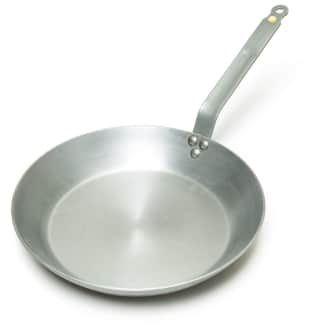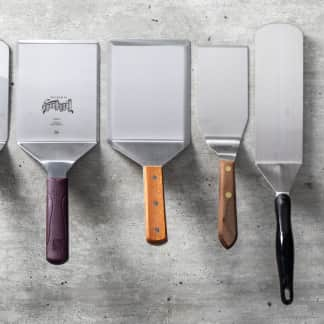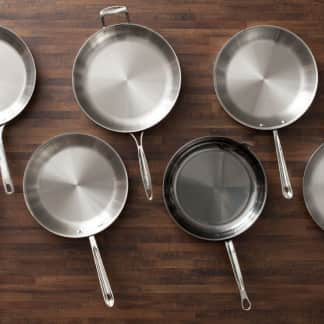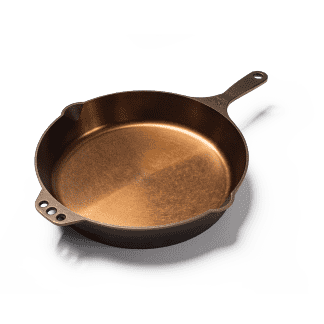The best carbon-steel skillets have thick, solid construction and smooth interiors, with minimal handle rivets (or none) to trap food, sides that are neither too high or too low, and an ergonomically angled handle. They brown food deeply and quickly acquire a slick, naturally nonstick surface. We think that the best carbon-steel skillet for most home cooks is the Mauviel M'STEEL Black Carbon Steel Round Frying Pan with Iron Handle, 12.6-in. While it’s a touch heavy, it performs beautifully and will last a lifetime. As an upgrade choice, we recommend the Northwest Skillet Company 12-Inch Carbon Steel Fry Pan. This gorgeous pan is handcrafted in Oregon and comes preseasoned, eliminating some of the work required with our top choice. It is incredibly durable and browns and releases food especially well.

Restaurant chefs have used carbon-steel skillets for decades. Now home cooks are embracing them too. We love them for all kinds of cooking tasks, from searing steak and sautéing onions to cooking eggs and even baking desserts, since they easily work both on the stove and in the oven. A carbon-steel pan is probably the most versatile skillet in your kitchen. It shares the durability of stainless steel and the heat retention of cast iron but with far less weight than a cast-iron pan. Like cast iron, carbon-steel pans become naturally and renewably nonstick, releasing delicate foods such as fish and eggs easily. But unlike nonstick-coated pans that deteriorate within a few years, carbon-steel skillets last a lifetime, and are safe to use even if heated to high temperatures.



We love carbon-steel skillets for all kinds of cooking tasks, from searing steak and sautéing onions to cooking eggs and even baking desserts, since they easily work both on the stove and in the oven.
When buying a carbon-steel skillet, you have a few decisions. You can choose between budget-friendly factory-made pans and pricier hand-crafted ones. You can choose a lightweight, thin pan or a thick, heavy one. You can pick whether you want it preseasoned. Because plain carbon steel will rust if exposed to air and moisture, a carbon-steel pan needs to be seasoned to protect it. This is typically a very thin coating of cooking oil heated to polymerize and bond to the surface, shielding the pan from rust. Over time, as you use the pan for cooking, seasoning becomes fully established.

Traditionally, carbon-steel pans have been sold unseasoned, leaving it up to the buyer to begin this process. Increasingly, manufacturers are selling preseasoned pans, letting consumers start cooking right away. A third, less common option is “blue” carbon steel—regular carbon steel that’s intensely heat-treated to oxidize and seal its surface, preventing rust, which turns it blue. In our experience, this jump-starts the seasoning process, but you still have to season these pans to make them nonstick. We bought pans in each of the three styles to test.
All About the Matfer Bourgeat Recall
Matfer Bourgeat Black Steel carbon-steel skillets were recalled in France. We explain why.What Size Skillet Should You Get?
Skillet size | Skillet size 11"-12" skillet | Skillet size 10" skillet | Skillet size 8" skillet |
|---|---|---|---|
Best for | Best for
| Best for
| Best for
|
We like to have a variety of sizes for different tasks. Skillets are measured across their top rim. For most home kitchens, we recommend an 11- to 12-inch carbon-steel skillet, a size we’ve found roomy enough to cook for up to six people. It’s great for cooking a few fish fillets, two medium-size steaks, or up to six burgers. A 10-inch skillet is best when cooking for two to four people: searing a single steak, cooking an omelet, or making a scaled-down shepherd’s pie. Finally, an 8-inch carbon-steel skillet is a good option when cooking for one or two—it’s great for scrambling a couple of eggs, searing a single fish fillet, or small tasks such as toasting nuts or browning butter.
What Are the Disadvantages of Carbon-Steel Cookware?
If you simmer an acidic tomato sauce in a carbon-steel skillet, as we did when we made a batch of Skillet Lasagna in our winning pan, the acid will strip off most of the pan’s dark patina and the shiny silver interior of the skillet will reappear. However, we didn’t notice any off-flavors when we tasted the lasagna, and a few rounds of stovetop heating and wiping the skillet with oil, which took about 10 minutes, restored the slippery patina. Also, remember that even when your carbon-steel pan is fully seasoned, you still need to use a bit of fat to cook with so that food won’t stick.
Contrary to the conflicting advice you can find online, putting the first layer of seasoning on new, uncoated carbon-steel cookware is neither time-consuming nor difficult.
Are Expensive Carbon-Steel Skillets Worth the Money?
We included a few pricey handmade carbon-steel skillets in our testing lineup. We found them beautiful—and they performed beautifully too. If your budget extends to supporting the kind of skill and craft that goes into producing this cookware, we think it’s well worth it to seek out the models we tested. We’ve designated an upgrade pick, the Northwest Skillet Company 12-Inch Carbon Steel Fry Pan, as our top option in this category. However, it must be said that artisan pans didn’t perform significantly better than our factory-made favorites, so from a purely practical standpoint, you don’t need to spend hundreds of dollars.


We pan-seared steak in each skillet (left) and made Tarte Tatin (right), which starts cooking on the stove and moves to the oven, then the pan is flipped to release the tart.
What to Look For
- Thick Construction: Carbon-steel skillets are made from a metal sheet that is shaped to form the pan. The steel’s gauge, or thickness, determines how heavy-duty the pan will be. Our preferred pans were made of 11- or 12-gauge steel. (Lower gauge numbers are thicker than higher numbers.) While any sheet of metal can warp, especially under thermal shock—a rapid change from hot to cold or vice versa—in our experience, thicker pans are less likely to warp.

- Smooth Surface: Whether you buy an unseasoned pan or choose a preseasoned model, look for a smooth surface, which helps it become nonstick reasonably quickly while gradually acquiring a patina of seasoning over time.
- Low, Flaring Sides: We preferred skillet sides that were high enough to contain splatters but low enough to make it easy to slide a spatula under food without breaking it up or holding our arms at awkward angles. About 2 inches was the sweet spot.

- Balanced Weight: Carbon-steel pans may be lighter than cast iron, but none of these pans are featherweights. An even balance of weight between handle and pan makes them easier to maneuver.
- Grippy Metal Handles: Every pan we tested had metal handles, which let us use them in the oven without worry. We preferred handles that were textured, as these stayed anchored in our hands.

Nice to Have
- Helper Handle: While it’s not essential, we liked having a helper handle, which can come in handy for moving heavier pans when they are full of food.
What to Avoid
- Thin, Lightweight Construction: Thinner pans of less than 2.6 millimeters tended to scorch food, throw off recipe times, and warp.
- Poor Factory Preseasoning: Some preseasoned pans were harder to use than unseasoned ones, rapidly losing the head start that preseasoning was supposed to provide. Food stuck even when we carefully followed instructions.

- Rough Interior Surfaces: One preseasoned pan had a pebbly surface that didn’t release food reliably, even after several rounds of cooking.
- Unbalanced Weight: When you lift a pan, it shouldn’t feel like someone is pulling down on the other side. This makes pans feel heavier and more awkward to maneuver.
- High, Bowl-Like Sides: Lower sides on a skillet encourage moisture evaporation so that pans can brown food more effectively. High sides make it awkward to reach under food with a spatula.
Other Considerations
- Preseasoned or Unseasoned Pans: While it’s up to you whether you want to prep your own pan the first time, we liked pans in both styles. Contrary to the conflicting advice you can find online, putting the first layer of seasoning on new, uncoated carbon-steel cookware is neither time-consuming nor difficult. It can also be very satisfying, as you learn about your pan and control the process.

- Rivets: We really enjoyed using pans with flat handle rivets on the interior of the pan; these pans were easier to clean, and had nothing to interrupt the swipe of a spatula. While bumpy rivets were not deal breakers, food stuck to them and made cleanup a little trickier.


Picking stuck food out of bumpy handle rivets inside the pan makes cleanup take longer.
- Blue Carbon Steel: While we didn’t find it essential, we liked pans that blued their carbon steel, a heat treatment that oxidizes and protects the surface from rust.
The Tests
- Do initial seasoning of pan, if needed, according to manufacturer instructions
- Fry egg in 1 teaspoon butter to test seasoning
- Make Perfect French Omelet
- Pan-sear steaks from Steak Frites recipe
- Simmer acidic pan sauce
- Bake Tarte Tatin
How We Rated
- Performance: We considered the cooking results that we were able to attain using each skillet, including how deeply foods browned and how readily the skillet’s surface released food.
- Ease of Use: We evaluated design factors—including the weight and balance of the pan, how well recipes fit in the pan’s available space, the comfort of its handle angle and the height of its sides—that helped make the pan easier to use.
- Cleanup/Durability: We assessed how easy it was to clean and maintain each pan in good condition after cooking.

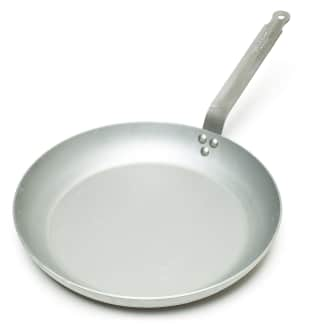


 Buy at Northwest Skillet Company
Buy at Northwest Skillet Company

 Buy at Smithey
Buy at Smithey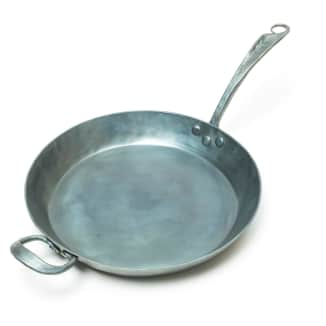
 Buy at Blu Skillet Ironware
Buy at Blu Skillet Ironware
